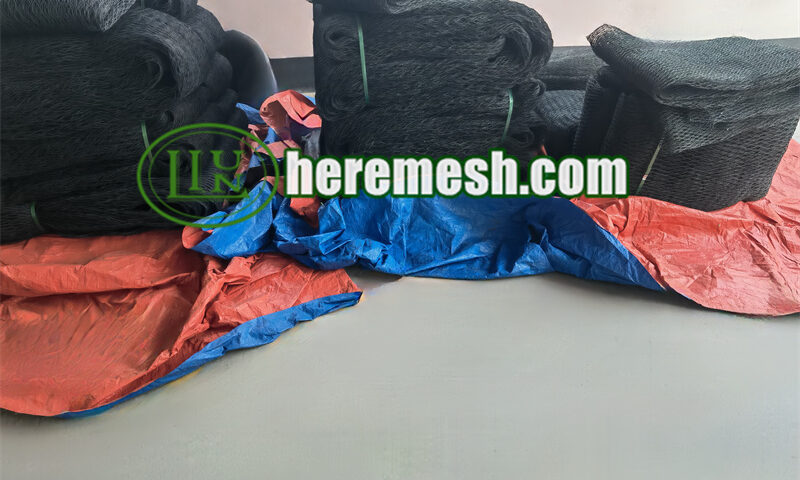Black Cable Mesh Stadium Project: From Raw Materials to Delivery

Clear View Flexible Cable Mesh for Animal Enclosures
10/24/2025
Transparent and Durable Park Fencing Barrier
11/06/2025This document details the production, quality control, and international logistics shipping process for an order of black cable mesh. The order was placed by a UK user for use in a stadium safety system project. This shipment will serve as safety netting, with core functional requirements including high strength, corrosion resistance, visual transparency, and durability for long-term outdoor use. This document systematically outlines each stage of the product lifecycle from raw materials to delivery, incorporating images of both raw materials and finished goods.
Strict quality control of raw materials, utilizing premium austenitic stainless steel wire, ensures the cable mesh’s high strength and corrosion resistance. During production, advanced weaving techniques and a rigorous quality control system were implemented. This not only met the visual transparency requirements but also ensured the product’s durability for long-term outdoor use. Ultimately, this batch of black cable mesh was successfully shipped via international logistics, providing reliable safety assurance for the UK user’s stadium safety system project. This entire process exemplifies systematic management from raw material selection to finished product delivery, highlighting the dual strengths of product quality and service excellence.
Black Cable Mesh Specifications and Raw Materials
Core Raw Material: Austenitic Stainless Steel Wire
The raw material for manufacturing black stainless steel rope mesh is high-quality austenitic stainless steel wire. Usually, AISI 304, 304L or 316, 316L materials are selected. The choice is primarily based on the environmental corrosiveness at the project location.
304/304L Stainless Steel: Suitable for most conventional atmospheric environments, offering good resistance to acid, alkali, and salt corrosion.
316/316L Stainless Steel: Contains molybdenum, significantly enhancing corrosion resistance beyond 304. Particularly suitable for marine climates or areas with heavy industrial pollution. For this project, 316 material was selected as the raw material to ensure an exceptionally long service life based on the environmental conditions and application scenario.
Raw material steel wire must comply with stringent international standards. During stainless steel cable mesh production, Liulin Company strictly controls mesh aperture, wire diameter, and aperture size. The chemical composition of Liulin’s selected raw materials falls within standard ranges, fundamentally guaranteeing material corrosion resistance and mechanical properties. We adhere strictly to green development principles, offering recyclable products that prevent resource waste.
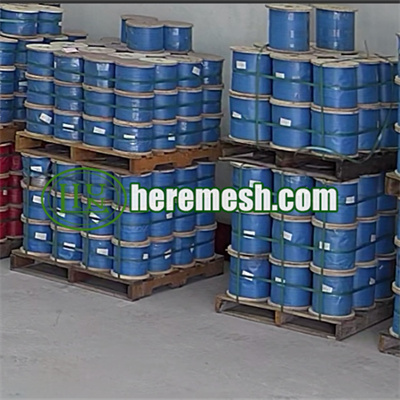
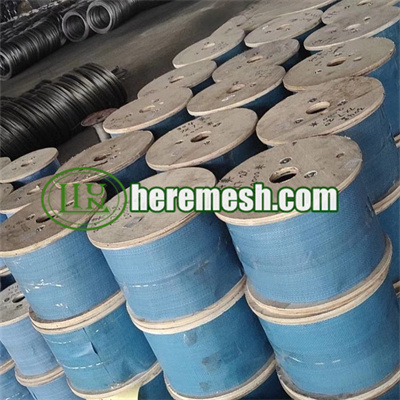
Black Cable Mesh Structure and Weaving Techniques
Black stainless steel wire rope netting is not welded but hand-woven into shape. This construction avoids the potential brittleness caused by heat-affected zones in welding. It enables the netting superior impact resistance and flexibility.
Rope Construction: Multiple ultra-fine high-strength stainless steel wires are first twisted into strands. Several strands (commonly 7×7, 7×19, etc.) are then twisted around an independent metal core to form a robust rope. The 7×7 configuration indicates 7 strands, each composed of 7 twisted wires. This structure offers flexibility and high strength, suitable for diverse applications.
Rope Mesh Type: This project utilizes diamond-weave rope mesh.
Diamond Weave: The most common type, featuring diamond-shaped openings that provide excellent elasticity and impact resistance.
Ferrule Type: Ferrule mesh secures mesh sections with ferrules, offering structural stability, a visually uniform appearance, and superior decorative effects.
Mesh Aperture Size: Determined based on user requirements and the object being protected/decorated. Common specifications include 25mm x 25mm, 50mm x 50mm, 100mm x 100mm, etc. Precise mesh dimensions are critical for ensuring functionality.
Rope Diameter: Typically refers to the diameter of the final braided rope, ranging from 1.2mm to 3.2mm or even thicker. Diameter directly determines the rope net’s breaking strength.
Surface Treatment
To achieve a black appearance and further enhance corrosion resistance, stainless steel cable mesh requires surface treatment.
Oxidation Treatment: This is the most commonly used method. The woven stainless steel rope netting undergoes oxidation treatment. The finished product exhibits a uniform matte black finish.
Superior corrosion resistance: Provides a physical barrier for the internal wires, effectively resisting UV rays, moisture, and chemical erosion.
Color Selection: Black is the most common choice, blending seamlessly into natural or architectural environments to minimize visual disruption.
Preserved Flexibility: The oxidized mesh retains its inherent elasticity, preserving the rope net’s bending properties.
Uniform Color: The oxidized mesh exhibits consistent, flawless coloration.
Black Cable Mesh Production Process
1. Raw Material Inspection: Conduct random sampling of incoming stainless steel wire to verify diameter, composition, and surface quality.
2. Stranding and Rope Laying: Combine individual wires into strands, then twist multiple strands around a core to form ropes of specified diameter and structure.
3. Weaving Formation: Weave ropes into mesh according to preset aperture and panel dimensions, ensuring secure and uniform knots at grid intersections.
4. Edge Treatment: Mesh edges are typically secured with metal clips to prevent fraying and facilitate installation.
5. Oxidation Treatment: This critical step creates the “black” appearance and enhances surface properties. A dense black oxide layer is chemically formed on the wire surface. This process yields a uniform, durable matte black finish and further improves the rope’s corrosion resistance. Black cable mesh is suitable for applications requiring reduced light reflection.
6. Finished Product Inspection: This is the core process ensuring product quality.
Dimensional Accuracy: Using tools such as calipers and tape measures, comprehensively inspect mesh aperture size, rope diameter, overall length/width dimensions, and diagonal deviation to ensure they fall within allowable tolerances.
Breaking Strength Testing: Regularly sample products and test them on a tensile testing machine to ensure the breaking strength of finished ropes meets or exceeds design specifications.
Coating Quality: Inspect the oxide coating for defects such as color uniformity and adhesion.
Visual Inspection: Check the entire net surface for broken strands, rust spots, stains, and irregular weaving knots.
Packaging Inspection: Ensure packaging methods effectively protect products from damage during long-distance transportation.
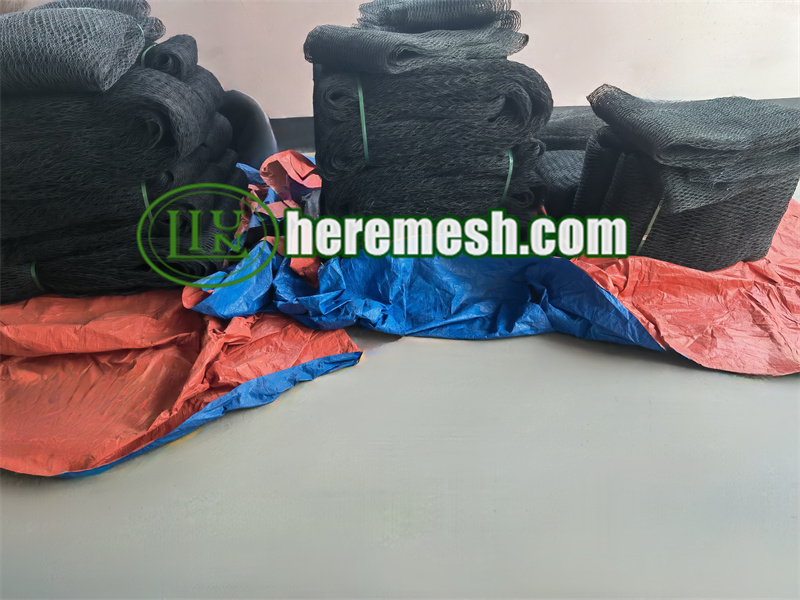
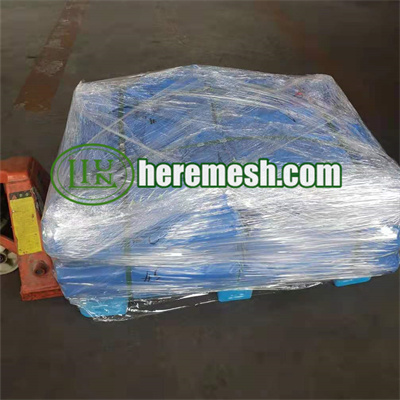
Packaging and International Logistics
3.1 Specialized Packaging Solution
To prevent black cable mesh from being scratched, crushed, deformed, or dampened during transportation, we employ the following packaging methods:
Inner Layer Protection: First, wrap the mesh surface with soft materials, particularly protecting edges and joints.
Waterproofing: Outer packaging utilizes waterproof woven plastic fabric to prevent moisture absorption during ocean shipping.
Securing and Support: The wrapped mesh panels are secured to sturdy pallets using strapping to prevent sharp kinks. For larger quantities, multiple pallets are employed for packaging.
Shipping and Customs Documentation Preparation: For shipments to destination countries, we prepare comprehensive commercial and shipping documents to ensure smooth customs clearance.
Installation Guide and Maintenance Recommendations
Although detailed installation plans are developed by the project owner or professional installation teams, as the supplier, we provide the following general guidelines.
Support Structure: The rope netting must be installed on sufficiently robust support structures (e.g., steel structures, concrete columns). The design and anchoring of the support structure must be capable of withstanding the long-term load of the tensioned rope netting, as well as anticipated external forces such as wind pressure and impact.
Tensioning System: Typically, bolts, tension clamps, and similar accessories are used to adjust and maintain the net’s tension, preventing slack.
Connectors: All connectors attached to the rope net—such as carabiners, shackles, and bolts—should be stainless steel to prevent electrochemical corrosion.
Specialized Tools: Use professional tools for cutting and tensioning to avoid damaging the net panels.
Regular Inspections: Conduct comprehensive inspections every 6 to 12 months, focusing on connection integrity, net tension, and coating integrity. Shorten inspection intervals in harsh environments.
Cleaning: Dust can typically be removed with clean water and a soft cloth. For stubborn stains, use a neutral cleaner. Avoid strong acids, strong alkalis, or organic solvents.
Local Repairs: If minor mesh damage is detected, perform localized repairs.
Conclusion
This order for black stainless steel cable mesh for the UK stadium project adheres to international standards and client specifications at every stage from rigorous raw material selection and precision weaving with surface treatment processes to comprehensive quality control and professional export packaging. With its high strength, exceptional weather resistance, aesthetic appeal, and safety features, this product fully meets the project’s long-term usage requirements. We guarantee this shipment will be delivered to the designated location in optimal condition, providing reliable product support for the project’s successful implementation.
Email:[email protected]/[email protected]
Website:www.heremesh.com


